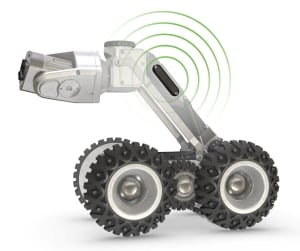In the utility locating industry, sondes are radio transmitters that are used to locate non-metal underground utilities. Sonde locating works best when you have an easy access point, as these transmitters are inserted into pipes to identify their location.
Sondes are an essential part of the locating process because non-metal assets like sewer pipes, storm drains and conduits are extremely common. When used with video inspection crawlers, these transmitters can determine the location of blockages and pipe defects. Sondes are also helpful for improving inaccurate or incomplete utility maps.
How Do Sondes Work?
The transmitter emits an electromagnetic (EM) field at a standard frequency, usually 512 Hz (in the United States). As the sonde moves through the pipeline this electromagnetic field moves with it. Above ground, the operator uses an EM locator or receiver to detect and mark the transmitter’s location.
The sonde’s signal is limited, meaning that the operator must have a general understanding of the pipe’s position before locating. Due to its limited signal the depth accuracy of sondes is not perfect, but it helps locators get a rough estimate of pipe depth and length.
How Are Sondes Operated?
Operators follow a specific process when performing a sonde locate. First, the operator inserts the sonde into a non-metal pipe, either via a cable or “snake” if it’s a standalone device or as part of a larger piece of assessment equipment. Next, the operator uses a locator to locate the sonde's signal. The operator then marks out the pipe’s position on the ground with paint or flags. Then, the operator pushes the sonde further into the pipe, uses the receiver to relocate the transmitter, and again marks the pipe’s location. The operator repeats this process until they have traced the desired length of pipe, and/or identified the location of connections, bends, defects or other features.
How Are Sondes Used With Inspection Crawlers?
While sondes can be standalone devices, they are usually built into CCTV inspection crawlers, push cameras, lateral launch systems and other kinds of assessment equipment. Standalone sondes have to be attached to a long cable or “snake” to allow operators to push them into pipes. Inspection cameras with built-in sondes provide operators with real-time video footage that can help identify potential pipe issues and indicate exactly where underground those defects are. This footage gives utility locators and pipe inspection professionals deeper insight into the problem they’re dealing with in the pipelines below, ensuring they know both the location and the nature of any damage.
Envirosight’s ROVVER X SAT II lateral launch crawler has twin sondes built-in, so sewer repair pros and locators can always have eyes underground. Ready to discover how ROVVER X SAT II can upgrade your locating capabilities? Request a demo today and see it for yourself.

